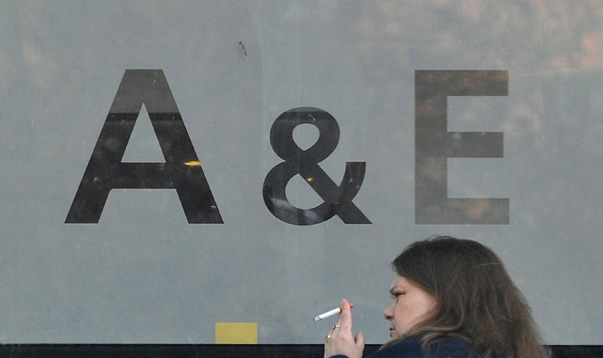What’s the problem?
The NHS is failing to meet key performance indicators, including the headline target that 95 per cent of patients who go to accident and emergency should be treated, transferred or discharged within four hours.
Nationally, the target has not been met since September last year.
Problems in A&E departments are often seen as a litmus test of how well things are going in the wider NHS.
The Nuffield Trust has said the accident and emergency system is “near breaking point” and that cracks are starting to show across hospital services, with “a decline in performance in nearly all measures in the most recent quarters”.
What’s causing the crisis?
If there’s one thing experts agree on, it’s that the causes of the recent difficulties in A&E are complex, and there’s no one simple solution.
Possible explanations that have been put forward include: the ageing population; people finding it harder to see their GP; growing expectations of a 24-hour service; cuts to social services budgets; immigration; staff shortages.
Politicians have tended to try to blame one of these factors alone – usually for political reasons, often with little statistical evidence.
The Health Secretary, Jeremy Hunt, has said changes to GPs’ working hours brought in by Labour mean people find it more difficult to see a doctor out of hours.
But there is no evidence of a significant rise in the proportion of people going to accident and emergency departments at evenings and weekends.
Shadow health secretary Andy Burnham has said cuts to social care budgets are a “root cause” of the A&E crisis.
It’s true that social care has not been protected from cuts, but that alone can’t explain the growing problem of “bed blocking” – patients being kept in hospital because there is nowhere else in the system for them to go.
The statistics show that the proportion of delayed discharges attributed to social care has actually fallen over the last five years(although this could reflect changes to the social care system).
It’s complicated, in short, and any politician who claims to have identified a single cause of the A&E crisis should be treated with scepticism.
Is there a funding gap?
We can all agree that more people are using NHS services at the same time as budgets are being squeezed.
Admissions to A&E have gone up by nearly 1 million a year in a decade. Real terms spending has been almost flat since 2009 after decades of strong growth.
There’s a wide acceptance across NHS organisations and think tanks that the post-recession spending slowdown and increasing numbers of service users is creating a substantial funding gap.
NHS England’s latest five-year plan says there will be “a mismatch between resources and patient needs of nearly £30bn a year by 2020/21”.
It suggests that £22bn can be found by efficiency savings, which means the next government will have to stump up an extra £8bn a year by the end of the next parliament.
These, if anything, are conservative figures. The health service watchdog Monitor has said savings of £10.6bn to £18bn are more realistic, and the Nuffield Trust has said the funding gap could be as high as £54bn.
Which party will spend the most?
On the face of it, the Liberal Democrats.
The Conservatives have announced an extra £2bn a year, calling it a “down payment” on the £8bn NHS England is calling for. Critics have pointed out that £750m of the £2bn is being recycled from elsewhere in the Department of Health budget.
The Tories have only said they will protect the NHS budget in real terms over the next parliament, not meet that NHS England target in full.
With much fanfare, Labour promised £2.5bn a year over and above the Conservative plans. But only later did they mention that the money would not be in place in full until 2017/18.
Ukip leader Nigel Farage has committed to an extra £3bn a year for frontline services, apparently dependent on Britain leaving the European Union.
Only the Lib Dems have explicitly said they will increase funding by at least £8bn per year in real terms by 2020.
There’s a big caveat here: no one has said what they will do with social care spending.
The Lib Dems say they will pool the social care and NHS budgets, but it’s not clear what overall spending would be.
Labour have plans to bring social care and healthcare together too, but again the costs and final budgets are unclear.
It’s also unclear how Labour would achieve their vision of “whole person care” without the kind of top-down reorganisation of the system they accuse the coalition of overseeing.
Are you sure the Conservatives aren’t planning to cut the NHS?
That might be the impression you got if you look at the stuff Labour have been tweeting recently:
But the Conservatives have explicitly said they would protect the NHS budget from cuts.
Labour say George Osborne won’t be able to make enough savings elsewhere to spare the health service, saying the Tories have a “secret plan” to cut the NHS.
But this is theory, not fact, and it’s hotly denied by the Conservatives.
Has the NHS been privatised?
Not according to the King’s Fund, who say only about 10 per cent of NHS spending goes to non-NHS organisations, after critics said the coalition’s reforms would open the door to widespread privatisation.
That 10 per cent includes private companies as well as councils, charities and voluntary sector groups.
The think-tanks says: “There has been growth in non-NHS provision of care, but there has been no wholesale privatisation of the NHS.”






